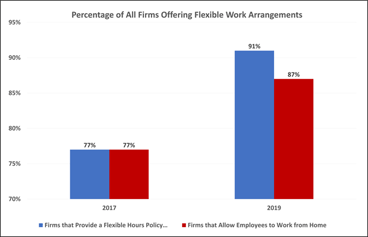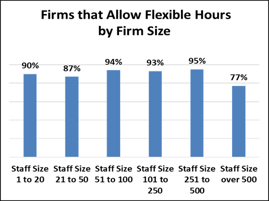 From engineering to architectural, small to large, firms have joined the national movement and embraced flexible working arrangements. A growing number of A/E firms are opting to be flexible when it comes to where and how employees work.
From engineering to architectural, small to large, firms have joined the national movement and embraced flexible working arrangements. A growing number of A/E firms are opting to be flexible when it comes to where and how employees work.
“Firms are establishing core hours,” explains according to PSMJ Senior Principal Dave Burstein, P.E.,“and the trend is toward allowing more flexibility when it comes to when people are in the office, and if they work from home.”
Meanwhile, PSMJ's 2019 A/E Bonus & Benefits Benchmark Survey has found that in fact increasing numbers of A/E firms offer both flextime and telecommuting. Moreover, this survey find that while small firms are more willing to allow flex time and large firms are more willing to let employees work at home
 Flextime Policies and Benefits. A flextime policy permits employees to set their own individual schedules for starting and stopping work. Most flextime policies establish requirements that employees work a defined numbers of hours per week (e.g., 40 hours). Typically, firms also require that all employees are in their office during a specified time period, for example between 10 a.m. and 3 p.m. Employees are permitted to begin any time before 10 a.m. and leave any time after 3 p.m., as long as they meet their total workday or workweek time requirements.
Flextime Policies and Benefits. A flextime policy permits employees to set their own individual schedules for starting and stopping work. Most flextime policies establish requirements that employees work a defined numbers of hours per week (e.g., 40 hours). Typically, firms also require that all employees are in their office during a specified time period, for example between 10 a.m. and 3 p.m. Employees are permitted to begin any time before 10 a.m. and leave any time after 3 p.m., as long as they meet their total workday or workweek time requirements.
Flextime tends to be extremely popular with most employees and is considered to be important as an employee benefit. It is especially critical to young professionals who need flexible work scheduling for child care, etc. Per PSMJ's 2019 A/E Bonus & Benefits Benchmark Survey, almost all firms (an overall median of 91 percent) have authorized flextime for their employees, an increase from 77 percent reported in the 2017 edition. However, while flextime is a popular choice among many types of firms, when broken down by firm size (see chart above), those with more than 500 employees are the least likely (77 percent) to allow flextime.
 Remote Working (Telecommuting) Policies and Benefits. Working at a site that is remote from the normal work location/office is typically called telecommuting. In these situations, the employee is permitted to work from a location of their choice, for example their home. This policy doesn’t include work performed by employees at company-required sites, such as client offices or project sites.
Remote Working (Telecommuting) Policies and Benefits. Working at a site that is remote from the normal work location/office is typically called telecommuting. In these situations, the employee is permitted to work from a location of their choice, for example their home. This policy doesn’t include work performed by employees at company-required sites, such as client offices or project sites.
According to PSMJ's 2019 A/E Bonus & Benefits Benchmark Survey:
-
More than three-quarters (87 percent) of firms have a policy that permits telecommuting. This percentage has increased significantly since 2017 (77 percent), reaching an all-time high this year.
-
It appears large firms are more likely than small firms to allow their employees to telecommute.
-
In fact, almost all firms with more than 250 employees report that some of their current employees are performing work from remote sites.
-
Firms that have telecommuting policies in effect report that only 65 percent have employees actually using this policy. However, this percentage has increased significantly in comparison to the 2017 survey report (50 percent).
PSMJ's 2019 A/E Bonus & Benefits Benchmark Survey also offers statistics on how benefits affect turnover, offering a look at specific benefits such as insurance, retirement plans, vacation time, and bonuses. The best way to reduce turnover, i.e., keep and retain employees? Invest time and money on both flexible working relationships and a bonus program, according to Burstein. “The war for talent will not be won with generic plans,” he concludes. “Today’s professionals want bonus and benefits programs that work with their specific needs in mind.”
 Now in its 10th biennial edition, PSMJ's 2019 A/E Bonus & Benefits Benchmark Survey Report provides data on the various types of incentive bonus plans and other employee benefits provided by firms in the A/E industry. In addition, the report analyzes the level of satisfaction with various types of bonus and benefit plans. We report the results by firm size, type of service, geographic location, type of client, and client marketplace. To benchmark your A/E firm’s bonus program, employee benefits, and much more, get your copy now.
Now in its 10th biennial edition, PSMJ's 2019 A/E Bonus & Benefits Benchmark Survey Report provides data on the various types of incentive bonus plans and other employee benefits provided by firms in the A/E industry. In addition, the report analyzes the level of satisfaction with various types of bonus and benefit plans. We report the results by firm size, type of service, geographic location, type of client, and client marketplace. To benchmark your A/E firm’s bonus program, employee benefits, and much more, get your copy now.
You also might be interested in these related posts:
Project-Based Businesses and Incentive Compensation
Compensation Benchmarking: How Your Strategy Can Measure Up


